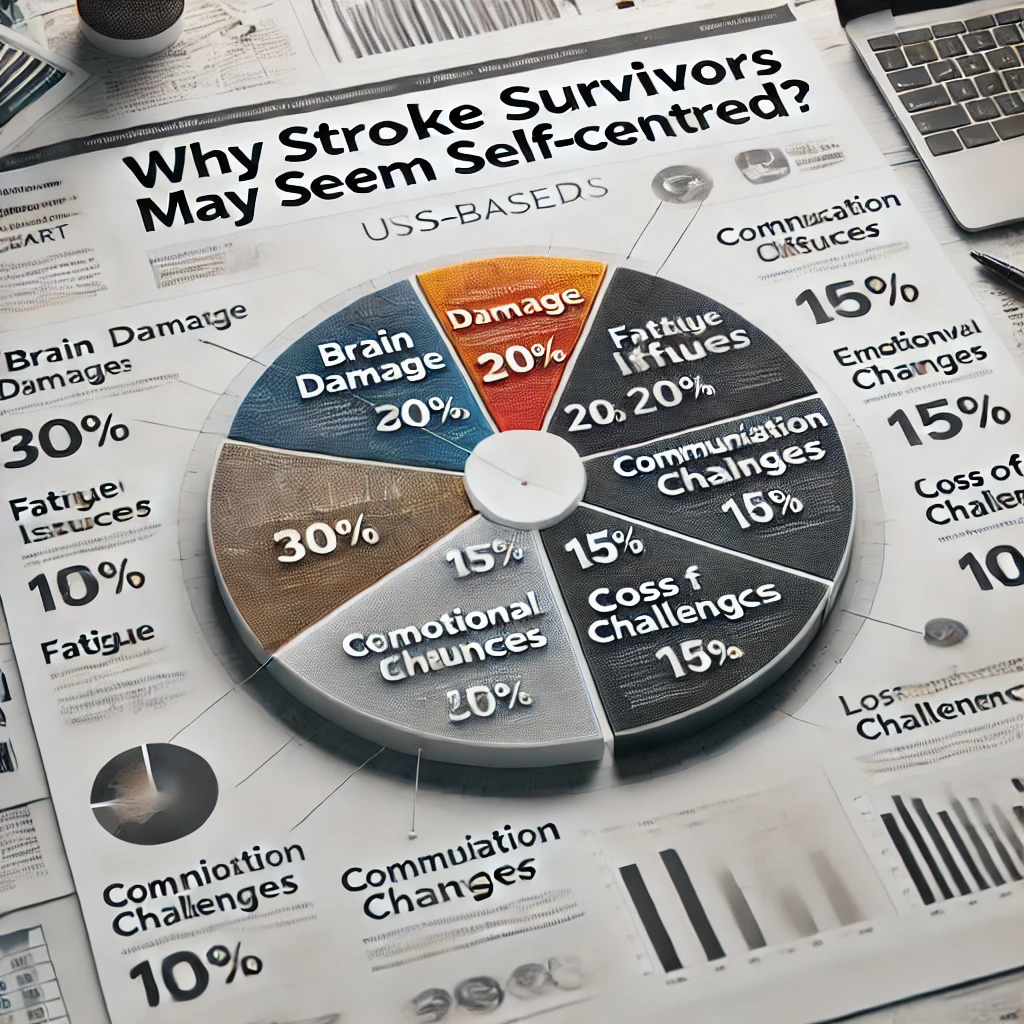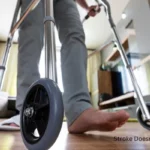After a major medical event, a person may notice real changes in thinking, emotions, and daily function. One hard challenge that can follow involves personality shifts, often showing up as stronger focus on personal needs. They may act differently, and you might struggle to recognize them. Loved ones may feel confused, hurt, or pushed away.
Why does this happen? Will it last? Most important, how can everyone adjust and move forward side by side? This piece explores those questions and shares clear guidance, practical steps, and steady encouragement for anyone walking this demanding path.
Understanding Egocentrism After a Neurological Event
Being self-focused after a stroke is not a personal failing or intentional behavior. It’s often a result of the physical and neurological changes that occur in the brain during and after a stroke. To grasp this phenomenon, we must examine how brain function is impacted and how those changes can shape behavior.

Changes in Brain Function During This Condition
When blood flow is interrupted—either by a blockage or internal bleeding—certain areas of a control center no longer receive needed oxygen and nutrients. This lack of supply causes injury in affected regions. Effects vary widely depending on severity and location.
For example, damage to frontal lobe can alter decision-making abilities. Skills such as weighing choices, anticipating outcomes, or controlling impulses may be diminished. This area plays a key role in self-regulation, so injury can lead to sudden outbursts, poor judgment, and challenges in meeting social expectations. Everyday tasks, like following a conversation or planning next steps, may feel confusing or overwhelming.
Injury to right hemisphere often impacts spatial awareness and perception of surroundings. Individuals may collide with objects, lose sense of direction, or have difficulty maintaining attention in group situations. This area also helps interpret subtle signals, such as facial expressions, tone of voice, or gestures. Overlooking these signals can make social interactions more challenging.
Damage to left hemisphere usually affects language-related skills. Individuals may have trouble finding words, forming complete sentences, or understanding spoken information. Step-by-step reasoning and logical thinking may also be impaired, making tasks like following instructions, solving problems, or expressing ideas more difficult. These challenges can impact casual conversations as well as structured activities such as reading, writing, or participating in groups.
Each region plays an essential role in daily functioning. When any area is compromised, resulting changes may be misunderstood by friends or family. Shifts in behavior are not deliberate; they reflect neurological impact of injury. Patterns that emerge often require patience, adaptation, and proper strategies to manage over time.
Such changes can affect social interactions, making individuals appear more focused on personal needs, less aware of how others feel, or less inclined to engage in activities that don’t offer immediate personal benefit.
What Causes People to Be Self-Centered?
A shift in focus toward oneself after a neurological event can stem from several factors:
Disrupted Mental Functions
When specific regions of a brain are affected, a person may struggle with tasks that once felt effortless—like planning ahead, making basic decisions, or handling everyday challenges. These changes can make it harder to understand how actions affect people nearby. Picking up on social cues, interpreting reactions, or responding appropriately in shared moments may also become more difficult. Awareness of situations beyond personal needs can shrink, making daily interactions feel strained or one-sided.
Mental Shifts
It is common for individuals to experience depression, anxiety, or unpredictable moods after a major medical episode. These inner challenges can cloud judgment, narrow attention, and make it difficult to notice what is happening outside immediate struggles. Instead of processing a broader picture or engaging fully with surroundings, focus may turn inward, making presence and meaningful participation in daily life harder.
Physical Limitations
Following a major medical event, physical challenges can dominate daily life. Paralysis, extreme fatigue, and persistent pain often require constant attention. These struggles not only slow movement but also occupy considerable mental energy. Tasks that were once automatic now demand planning, patience, and effort. When simple actions like standing or lifting an arm become difficult, daily routines often revolve around managing these limitations, leaving little energy for anything beyond completing essential activities.
Survival Mode
After a traumatic event affecting brain function, attention often shifts to staying stable and meeting basic needs. This adjustment can temporarily reduce interest in mutual exchange or awareness of surroundings. Focus may move toward immediate comfort, daily routines, and personal safety. Such behavior is not selfish; it reflects how brain conserves energy and manages stress under strain.
During this state, outward engagement often decreases while mental energy concentrates on coping with pain, fatigue, or uncertainty. This response is involuntary, caused by neurological changes, rather than a conscious disregard for others.
How Relationships Are Affected
Shifts in personality after a neurological event can place serious strain on relationships with family, friends, and others involved in daily life. Close contacts may feel overlooked, ignored, or misunderstood when their needs receive little attention. Over time, this can create bitterness, growing distance, and frequent miscommunication.
For example, a spouse may feel weighed down by added responsibilities while longing for emotional closeness once shared. Adult children might wrestle with memories of who a parent used to be versus who they see now. Friends may slowly pull back, unsure how to connect with someone who shows little interest in moments once enjoyed together.
These challenges are amplified by a long and unpredictable recovery process. Loved ones may feel guilty for experiencing frustration or impatience, even while mourning changes in familiar dynamics and connections.
Coping Strategies for Those Recovering from a Brain Injury
If you’ve been through a major health event and find yourself focusing more on your own needs than before, know that this isn’t your fault—but it is something you can work on. Here are some strategies to help rebuild connections and regain a sense of balance:
Recognize What’s Different
Begin by paying attention to how reactions to everyday situations have changed. Noticing unfamiliar responses may feel uneasy, yet watching patterns in speech, decisions, or actions matters. Talking through these shifts with trusted friends or family can bring valuable perspective. Try to hear their observations without turning defensive. Goal is not blame—it is understanding and shared respect. Honest conversations like these can open path toward real progress.
Sharpen Inner Awareness
Pay attention to how focus and engagement appear during daily interactions. Are discussions frequently centered on personal concerns? Are signals from others being overlooked? Noticing these patterns can reveal habits that might unintentionally distance people. Awareness creates an opportunity for small, intentional adjustments, allowing more balanced exchanges and deeper mutual understanding.
Break Changes Into Simple Actions
Start with small, manageable steps. Ask how someone’s day went or express genuine gratitude when assistance is offered. These simple gestures can help rebuild trust and warmth over time. Consistent practice gradually strengthens connections and fosters a positive atmosphere in everyday life.
Explore Professional Guidance
Working with a therapist or counselor can provide insight into emotional and cognitive shifts, offering strategies to navigate challenges effectively.
Connect with Peers
Engaging with others who have experienced similar events can create a sense of community. Learning from those who have faced and adapted to similar situations offers valuable perspective and encouragement.
Tips for Those Helping Someone Through a Tough Time
If you’re caring for a stroke survivor who seems self-centered, it’s important to approach the situation with compassion and patience. Here are some strategies to help you navigate this difficult dynamic:
Learn Key Insights
Grasping how head injuries can affect behavior and social interactions is crucial. Knowing that changes in reactions or relationships often result from neurological shifts makes it easier to approach situations with patience and empathy rather than frustration.
Speak Openly Without Blame
Communicate respectfully about what’s happening. Keep tone calm and steady. Share how certain actions affect daily life using “I” statements, such as “I feel frustrated when my input isn’t considered.” This approach encourages open dialogue, allowing both sides to listen and respond thoughtfully without conflict.
Set Clear Boundaries
While patience is valuable, defining limits is crucial to maintain emotional balance. Express clearly what responsibilities you can manage and what actions you are willing to take. Outlining boundaries creates a more stable, respectful dynamic and reduces risk of feeling overwhelmed.
Focus on Personal Well-Being
Managing challenges after a neurological event can be mentally and physically draining. Make time for restorative activities and don’t hesitate to reach out to trusted friends, family, or a professional for guidance.
Acknowledge Small Progress
Growth isn’t always fast or dramatic, but even subtle efforts deserve recognition. When someone makes an attempt to engage, contribute, or show presence in new ways, acknowledge it. Celebrating small steps reinforces confidence and encourages continued movement forward. These moments are reminders that improvement is occurring, even if changes are gradual.
Rebuilding Connections
Rebuilding Connections
Restoring relationships after a neurological or medical challenge takes time, effort, and patience from everyone involved. Here are ways to strengthen bonds during this period:
Engage in Shared Activities
Spend time together doing simple things that bring enjoyment—watching a favorite show, playing a board game, or taking a walk. These moments create opportunities to laugh, reminisce, and form new memories. Even small shared activities can ease tension and bridge gaps created during challenging times. Focus on presence rather than perfection, showing that spending quality time together remains a priority.
Be Fully Present
When someone is speaking, give full attention. Silence phones, turn off distractions, and make eye contact. Nod, ask thoughtful follow-up questions, and allow pauses without interrupting. This level of presence fosters respect and encourages meaningful, unhurried exchanges.
Show Appreciation
Acknowledge efforts and presence regularly. A sincere “thank you” builds trust, reinforces that their presence matters, and conveys recognition. Small gestures of appreciation can make daily interactions feel more positive and strengthen emotional bonds.
Stay Calm and Understanding
Recovery and adaptation often come with highs and lows. Practice patience with yourself and with someone navigating this journey. Steady kindness and a willingness to move forward together foster a nurturing environment and promote gradual progress.
Role of Professional Guidance
Overcoming challenges is not something anyone should face alone. Professional support can be essential in navigating personal struggles. Here are some resources to consider:
Neuropsychologists: These specialists study how a brain influences thinking patterns, memory, decision-making, and mood. They conduct in-depth evaluations to identify areas where mental functions may have been altered due to an injury or medical episode. Based on findings, they develop personalized strategies to strengthen mental clarity, improve daily functioning, and ease distress that may come with shifts in how a person reacts or processes situations. Their role is especially valuable when clear, structured guidance is needed to help individuals navigate day-to-day life after significant neurological impact.
Speech Therapists: When a person struggles to express themselves clearly or understand what’s being said, these specialists step in to guide improvement of verbal expression and comprehension. Through structured sessions, they offer tools to rebuild language patterns, expand vocabulary, and practice clearer speech. Their work often extends to helping individuals engage more comfortably in social settings—whether chatting with family, participating in small groups, or expressing needs with more confidence.
Occupational Therapists
These specialists assist individuals in regaining confidence and independence in daily routines. Through structured practice and tailored strategies, they focus on improving skills for activities such as dressing, cooking, and personal grooming. Their guidance encourages moving beyond immediate challenges and reengaging with everyday life, fostering meaningful progress and a renewed sense of purpose.
Support Groups: Both individuals in recovery and caregivers can benefit from shared experiences and encouragement.
A Message of Hope
Experiencing a major medical event can leave someone feeling isolated or disconnected, but growth and connection remain possible. With time, steady effort, and structured guidance, rebuilding meaningful relationships is achievable. For those around them, showing patience and understanding can make a significant difference in fostering respect and appreciation.
Progress often arrives in uneven steps, and challenges belong to recovery. By standing with each person and using available tools or professional guidance, this journey can move ahead with strength and optimism. No one must face it alone—connections, strategies, and communities can offer direction along way.
Can this type of personality change improve over time, or is it permanent?
Encouraging Possibilities
It is important to remember that this self-focused tendency does not have to be permanent. With dedication and consistent effort, many people show meaningful progress. A mind can adapt and form new pathways—a process called neuroplasticity. Through regular practice and guided strategies, certain skills affected by injury can often be rebuilt.
Extent of improvement depends on several factors:
Severity and location of injury: Some regions may regain function more readily than others.
Commitment to rehabilitation: Engaging in cognitive exercises, speech therapy, and other structured practices can accelerate progress.
Support from loved ones and professionals: Encouragement and guidance from others can significantly influence recovery outcomes.
While some may experience substantial improvement, others may continue facing challenges. In such cases, focus shifts to managing tendencies effectively and developing approaches to maintain healthy, balanced relationships.
How can I tell if changes in personality after this kind of event are a sign of a more serious cognitive issue, like dementia?
Shifts in behavior or interactions after a head injury can sometimes be mistaken for early signs of dementia. However, causes and patterns are different. Both may influence how someone relates to others or manages daily routines, but they emerge and progress in distinct ways.
After a Serious Neurological Event:
Often appear suddenly.
May come with other physical or cognitive challenges, such as weakness, speech difficulties, or memory changes.
Can improve over time with consistent rehabilitation and strategies.
In Dementia Over Time:
Develop gradually.
Often include worsening memory loss, confusion, and difficulty performing familiar tasks.
Progressively worsen over time.
If such shifts raise concern, consulting a qualified specialist is essential. A neurologist or neuropsychologist can assess a situation, identify underlying causes, and recommend steps to address challenges and support recovery.
Are there specific activities or exercises that can help shift focus away from oneself after a stroke?
Yes, there are several activities and exercises that can help individuals become more engaged with others and less inwardly focused. These activities are designed to enhance cognitive function, emotional regulation, and social skills. Here are a few examples:
Mindfulness and Meditation:
Spending time in quiet reflection through mindfulness can guide someone toward greater awareness of thoughts and inner patterns. This gentle practice teaches a person to observe without judgment, allowing recognition of moments when focus turns too inward or when needs of others fade into background. With regular practice, pausing before reacting becomes easier, creating space to choose a different response—one that feels more considerate or open.
Meditation, even for just a few minutes a day, has been known to ease tension and bring a sense of calm. It helps settle racing thoughts, which often cloud one’s ability to connect meaningfully with others. When someone feels less overwhelmed, they’re often more present, more grounded, and better able to meet others where they are. Over time, these moments of clarity can lead to stronger bonds and a greater sense of belonging.
Interactive Role-Playing Sessions:
By spending time with a therapist or trusted companion, individuals can participate in guided role-playing exercises to refine daily conversation skills. These exercises simulate real-life situations—such as talking with a friend, meeting someone new, or navigating a disagreement—allowing practice in responding thoughtfully, listening attentively, and expressing ideas clearly.
Engaging in this type of structured practice allows someone to regain balance in back-and-forth interactions. It encourages asking meaningful questions, pausing for responses, and staying fully present during conversations. Over time, this approach enhances relational skills and builds confidence in handling various social situations.
Group Sessions and Shared Conversations
Participating in small group meetings creates opportunities for meaningful connection and discussion. Sharing stories in a supportive setting encourages new perspectives, deeper understanding, and practice in thoughtful listening and speaking. These interactions can rebuild confidence in social engagement and foster a sense of belonging that feels uplifting.
Volunteering or Engaging in Outward-Focused Activities
Taking part in activities that benefit others—such as volunteering or assisting friends or family—can shift attention outward and create a sense of purpose and connection.
Thinking Activities
Tasks that challenge reasoning and planning, like puzzles, brain teasers, or problem-solving exercises, help sharpen cognitive abilities. These activities enhance memory recall, decision-making, and mental flexibility—especially after events that impact how information is processed.
Examples include crosswords, Sudoku, matching games, sequencing drills, or structured storytelling. Activities like these engage multiple brain areas, sharpen decision making, and build awareness during everyday routines such as organizing tasks, following steps while cooking, or remembering important events. With regular practice, daily life can feel more focused, patient, and mentally sharp. These activities go beyond simple pastimes—they serve as tools for building resilience and encouraging steady cognitive growth.
Art or Music Activities
Creative engagement through painting, drawing, sculpting, playing instruments, or singing offers a strong outlet for self expression. Such activities activate brain areas that may stay responsive even after a major neurological event. Working with colors, sounds, rhythm, and textures lets people share thoughts and memories that feel hard to say out loud, giving emotional release along with mental engagement.
These artistic sessions often become a gentle space for release, allowing internal thoughts to come forward in a calm, non-verbal way. Over time, this kind of expression may help ease mental strain, reduce restlessness, and promote a sense of clarity. Additionally, when shared in a group setting or guided by a therapist, creative practices can help spark moments of shared understanding and comfort—offering a bridge between people who may be adjusting to new ways of interacting.
Whether through painting a canvas, tapping out a beat, or singing a familiar tune, these artistic forms allow space for exploration, healing, and rediscovery.
By incorporating these activities into daily life, individuals can gradually strengthen their social connections and improve overall well-being.
Final Thoughts
Changes in how someone acts or connects with others after a serious head-related event can feel confusing and be easily misinterpreted. These shifts do not define who they are—they result from lasting effects of an incident. When friends and family approach such moments with patience, awareness, and an open mind, it creates an opportunity to strengthen relationships, encourage understanding, and begin a fresh chapter together.
Healing is a journey—Recovery is a journey that requires time, resilience, and abundant compassion. With consistent effort and a positive mindset, it can lead to growth, renewal, and a deeper sense of meaning. Embrace each day, celebrate small victories, and hold onto hope as a guide toward progress.




